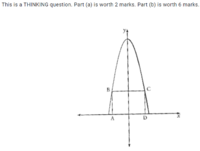NeedMathHelp12345
New member
- Joined
- Jun 6, 2021
- Messages
- 1
A rectangle ABCD is inscribed in the area between the x-axis and the part of the graph of y = cos(4x) between its x-intercepts (see diagram). (a) Determine the function that models the perimeter of ABCD as a function of x. (b) Determine the maximum perimeter of ABCD and the dimensions of this rectangle of maximum perimeter.
I don't even know where to start with this.
I don't even know where to start with this.


